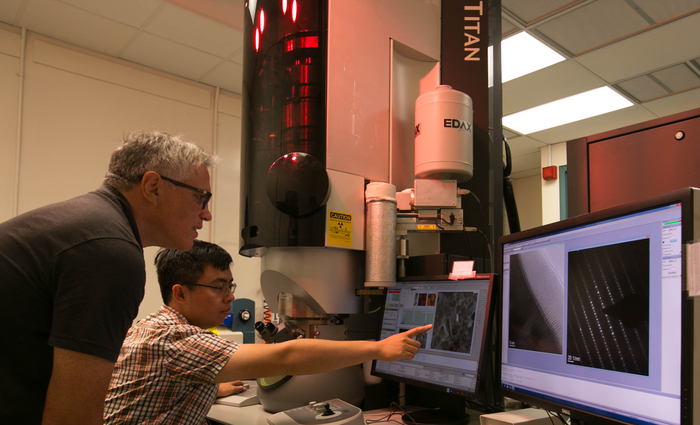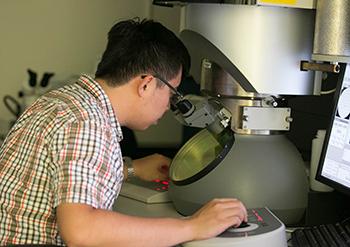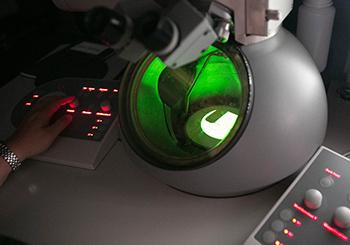New electron microscope expands materials characterization capabilities at Laboratory
 (Download Image)
Lawrence Livermore National Laboratory materials scientists Joseph McKeown (left) and Tian (Tony) Li (right) use the new FEI Titan transmission electron microscope to study the nanostructure and composition of metallic alloys. Li points to a bright crystalline grain ~100 nm in size and rich in zirconium, observed using Z-contrast imaging. Photos by Julie Russell/LLNL
(Download Image)
Lawrence Livermore National Laboratory materials scientists Joseph McKeown (left) and Tian (Tony) Li (right) use the new FEI Titan transmission electron microscope to study the nanostructure and composition of metallic alloys. Li points to a bright crystalline grain ~100 nm in size and rich in zirconium, observed using Z-contrast imaging. Photos by Julie Russell/LLNL
A new Transmission Electron Microscope (TEM) installed at the Lab earlier this year is giving LLNL researchers a clearer look at the atomic level of structures than they’ve had before.
The Titan 80-300 TEM, manufactured by FEI Company, was installed in December and brings an expanded capability to the existing transmission electron microscope the Lab has had for about 20 years, according to LLNL staff scientist Joe McKeown. Among the improvements include a high-angle annular dark field (HAADF) detector for scanning transmission electron microscopy (STEM), which allows for Z-contrast imaging due to enhanced scattering from high atomic number elements, and a low-voltage mode for analyzing polymers and biological samples that may be more sensitive to high-energy electrons.
"With the dark field detector, heavier elements appear brighter in contrast, so we can more easily and quickly perform both structural and compositional analysis of microstructures," McKeown said.
The microscope also has been fitted with an upgraded detector for electron energy loss spectrometry (EELS). The new detector (a Gatan 965 GIF Quantum ER) provides better energy resolution and allows for extremely fast elemental mapping of materials due to increased collection efficiency. Operations that would typically take a few hours, McKeown said, take only a few minutes with the state-of-the-art machine.
"In terms of timesaving, it’s enormous," McKeown said. "Having this new spectrometer is really nice for doing fine mapping because there’s much more signal to be collected."
Postdoctoral researcher Tian (Tony) Li, one of the new TEM’s primary users, said the Titan provides many new microscopy capabilities on site that he previously had to travel to Lawrence Berkeley Lab to perform. With its high-resolution imaging, Li said, researchers can see individual atomic columns, a useful tool for looking at lattice structures and doing composition analysis.
"You can get images down to the atomic level with the Titan and it’s also great for quantitative analysis," Li said. "You can do atomic-resolution imaging, diffraction, energy dispersive x-ray analysis, electron energy loss and tomography, and it has one of the best yield spectrometers out there."
McKeown said anyone interested in microstructures, including additive manufacturing, biology, or other areas that could benefit from nanoscale imaging, can bring samples in for analysis, and can even be trained on how to use it.
"You don’t have to be an expert to get some really good images," McKeown said.
Anyone interested in using the new TEM should contact mckeown3 [at] llnl.gov (Joe McKeown) or li48 [at] llnl.gov (Tony Li )to schedule a time.
Contact
 Jeremy Thomas
Jeremy Thomas
[email protected]
(925) 422-5539
Tags
Physical and Life SciencesFeatured Articles









